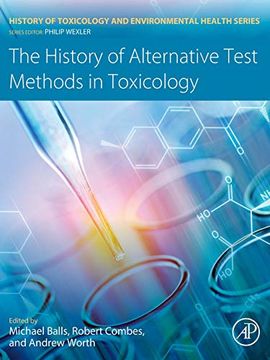The History of Alternative Test Methods in Toxicology (History of Toxicology and Environmental Health) (en Inglés)
Reseña del libro "The History of Alternative Test Methods in Toxicology (History of Toxicology and Environmental Health) (en Inglés)"
The History of Alternative Test Methods in Toxicology uses a chronological approach to demonstrate how the use of alternative methods has evolved from their conception as adjuncts to traditional animal toxicity tests to replacements for them. This volume in the History of Toxicology and Environmental Health series explores the history of alternative test development, validation, and use, with an emphasis on humanity and good science, in line with the Three Rs (Replacement,Reduction, Refinement) concept expounded by William Russell and Rex Burch in 1959 in their now classic volume, The Principles of Humane Experimental Technique. The book describes the historical development of technologies that have influenced the application of alternatives in toxicology and safety testing. These range from single cell monocultures to sophisticated, miniaturised and microfluidic organism-on-a-chip devices, and also include molecular modelling, chemoinformatics and QSAR analysis, and the use of stem cells, tissue engineering and hollow fibre bioreactors. This has been facilitated by the wider availability of human tissues, advances in tissue culture, analytical and diagnostic methods, increases in computational processing, capabilities, and a greater understanding of cell biology and molecular mechanisms of toxicity. These technological developments have enhanced the range and information content of the toxicity endpoints detected, and therefore the relevance of test systems and data interpretation, while new techniques for non-invasive diagnostic imaging and high resolution detection methods have permitted an increased role for human studies. Several key examples of how these technologies are being harnessed to meet 21st century safety assessment challenges are provided, including their deployment in integrated testing schemes in conjunction with kinetic modelling, and in specialized areas, such as inhalation toxicity studies. The History of Alternative Test Methods in Toxicology uses a chronological approach to demonstrate how the use of alternative methods has evolved from their conception as adjuncts to traditional animal toxicity tests to replacements for them. This volume in the History of Toxicology and Environmental Health series explores the history of alternative test development, validation, and use, with an emphasis on humanity and good science, in line with the Three Rs (Replacement, Reduction, Refinement) concept expounded by William Russell and Rex Burch in 1959 in their now-classic volume, The Principles of Humane Experimental Technique. The book describes the historical development of technologies that have influenced the application of alternatives in toxicology and safety testing. These range from single cell monocultures to sophisticated miniaturised and microfluidic organism-on-a-chip devices, and also include molecular modelling, chemoinformatics and QSAR analysis, and the use of stem cells, tissue engineering and hollow fibre bioreactors. This has been facilitated by the wider availability of human tissues, advances in tissue culture, analytical and diagnostic methods, increases in computational processing capabilities, and a greater understanding of cell biology and molecular mechanisms of toxicity. These technological developments have enhanced the range and information content of the toxicity endpoints detected, and therefore the relevance of test systems and data interpretation, while new techniques for non-invasive diagnostic imaging and high resolution detection methods have permitted an increased role for human studies. Several key examples of how these technologies are being harnessed to meet 21st century safety assessment challenges are provided, including their deployment in integrated testing schemes in conjunction with kinetic modelling, and in specialised areas, such as inhalation toxicity studies. Covers each global region in a systematic fashion, showing how regions compare in terms of problems faced and resolution approaches Includes a thorough chronology of alternatives research, thus providing a complete overviewFocuses on methods of direct relevance to humans to address issues of efficacy and waste

